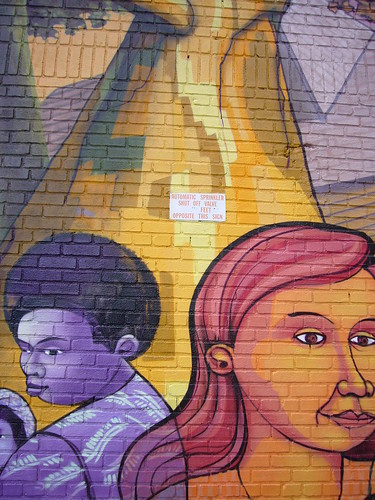
I'm home today recovering from a hectic
Open House New York weekend. This year, I feel that I finally took full advantage of the weekend, seeing 7 different sites and volunteering a shift. The most frequent comment that I've been hearing lately about OHNY is that there's too much to see in too little time. This is absolutely true, and it's a game of geography and prioritization. (It was also 85 degrees outside, so heat was also a factor for some attendees.)
I was lucky to get a spot on
Ellis Island's South Side tour. On Saturday, I woke at an extremely early hour to get to the Circle Line by 8 a.m. Fog was heavy in my Bronx neighborhood, and it was heavier in lower Manhattan, so heavy that the Coast Guard didn't let the first boat go until 10:15 a.m. (rather than the 8:30 boat that would've allowed the tour attendees to get to Ellis Island for the 9:30 a.m. tour). Since I had a 1:45 p.m. reservation on The High Line, I chose to forgo the later Ellis Island tour to ensure that I could visit the High Line. A new friend on line chose to give up her scheduled
Fresh Kills tour to attend the Ellis Island tour. (!) The
book will have to do for now...


I decided to go straight to
Chelsea and see whatever I could in that neighborhood before the tour. My first stop was the
General Theological Seminary on Ninth Ave. at 20th Street. It was a good warm-up spot and made me realize how a lot of Open House New York is (for me) about seeing the City in a different light. The Episcopalian Seminary is an entire city block of tranquility for the over 200 current students. The entrance building is going to be torn down in early 2008, and a higher building will take its place. Most of the OHNY sites that I visited will be changing architecturally in the near future.
Although listed in the OHNY guide,
The Desmond Tutu Education Center was not open. It is run by the General Theological Seminary, so signs directed vistors to that site.


Since it was in the neighborhood, the next stop was
Anderson Architects on West 25th Street. I could see its roof deck as I walked up 10th Avenue. Besides the gorgeous outdoor space, AA was interesting in that it was accessed via an elevator that opened directly to the street. (There's a gated door to the elevator that is swung open each morning.) The site gave me office envy, not only for the aesthetics of the space (both office and rooftop) but also for the creativity visibly demonstrated at each individual work station and throughout the floor.

Secret organizations are an interest of mine, and I quickly walked to the
Grand Lodge of Masons; I've been told several times to visit this site. (NOTE: It is open for public tours Monday through Saturday.)

Although
the rooms are grandly decorated, I most enjoyed hearing the Mason tourguides answer questions about
the Masons. (My grandfather was a Mason, and I remember going to Mason picnics when I was young.) Many ideals and concepts were repeatedly stated: "The brotherhood of man under the fatherhood of god, whomever you may conceive him to be"; "We are not a social club"; "We cannot talk about religion or politics."
We were told that we would be attending the short tour; the 75-minute long tour was given during the week. An hour later, we had only toured half of the rooms (the tour is 6 floors long, each floor being two stories tall), and we had to leave before seeing "the wow room" in order to make our High Line appointment.
The half hour
High Line tour covered what is known as "the upper third", the portion which runs over the West Side Rail Yards and is not secure from demolition (the other 2/3 of the High Line is secure and in construction to become a public park). We walked during the entire tour, and the scenery changed dramatically. I had an opportunity to go on the High Line in (I think) 2001, and I didn't go, so I was very happy to have another chance.
Here's a view of the West Side Rail Yards:

The big picture:

Preparing the lower 2/3 to become a public park:

Photographer Joe Sternfeld's book
Walking the High Line documents the site circa 2000/2001. It is going to be reprinted this year with a few different photos, according to the Friends of the High Line volunteer that I spoke with on Saturday.
This was my Open House New York Saturday. The Sunday locations that I visited will be in another post.


















































